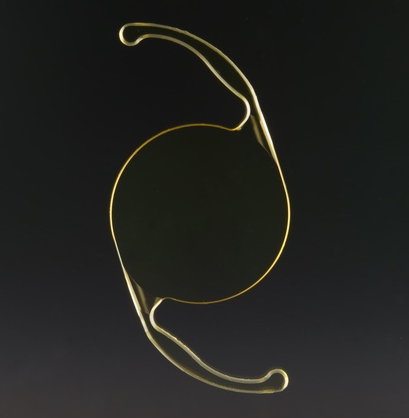

Building on Our Leadership in IOL Innovation
April 1, 2024
3 mins read


April 1, 2024
3 mins read
Cataracts are one of the most common vision conditions, affecting an estimated 65 million people around the globe.1 You or someone you know has likely had cataracts. It’s a natural part of aging, resulting in blurry vision from the natural proteins which build up in the eyes over time. And given the growing aging population, cataracts are only expected to become more prevalent in the future.
Certainly, a loss in vision, no matter how gradual, can be worrisome. The good news? Cataract surgery is one of the safest elective surgical procedures,2 and there is a breadth of options available now that can correct a patient’s vision at the time of surgery. Cataracts are often corrected with the surgical implantation of an intraocular lens (IOL), which is an artificial replacement for the eye’s lens.
Expanding on our leading line of IOLs, Alcon is rolling out its Clareon® family of IOLs in the U.S. and other countries this year for surgeons and their cataract patients. Clareon is Alcon’s most advanced cataract material to-date, and these IOLs can deliver excellent vision and exceptional clarity that lasts.*,3-9
This latest surgical offering from Alcon is the result of innovation at Alcon on every level – from our research and development to manufacturing to commercial teams. Our leading AcyrSof IQ® intraocular lenses are a great example of truly listening to what our customers want: long-lasting clarity and excellent vision.
Implanted in more than 135 million eyes globally in more than 140 countries, Alcon’s AcrySof IQ IOL platform has established itself as one of the most trusted IOL materials used by surgeons.9 This includes our monofocal IOLs and leading presbyopia-correcting IOLs. Clareon is built on the legacy of these Alcon IOLs, and the R&D team worked tirelessly to create the next-generation IOL technology – looking at every aspect of this material.
One of the initial steps of the IOL manufacturing process includes “curing” the IOLs in an oven. And since innovation is not achieved without challenges, Alcon was presented with a novel one – the oven traditionally used to create Alcon’s IOLs didn’t cure the new Clareon material.
Similarly, the equipment downstream in the manufacturing process needed to be tailored to accommodate the new material. Ultimately, new pieces of equipment were designed to create the IOL, including a unique cutting process that gives Clareon a precise design to help reduce glare.10 The Clareon IOL manufacturing equipment is now a proud addition to our Ireland production facility.
“We are consistently pushing the boundaries to deliver transformational innovation to cataract surgeons and their patients,” said Ian Bell, President, Global Business & Innovation, Alcon. “Clareon is the result of robust R&D efforts at every level – inventive material science, advanced manufacturing techniques and novel delivery systems – to deliver exceptional, long-lasting clarity.”
Improving IOL delivery systems can benefit both patients and surgeons; results can include a decrease in surgical time, precise application of the IOL, increased throughput (and less delays for the patients), and decreased surgical errors.11 After extensive research and collaboration with a diverse group of surgeons, Alcon developed the Clareon Monarch IV, a reusable IOL delivery system that provides easy, intuitive control for precise insertion during cataract surgery.10,12
Alcon continues to demonstrate its unwavering commitment to developing advanced, innovative IOLs that help meet surgeons’ needs in order to help their patients see brilliantly.
*Long term defined as over 3 years (n=138), and over 9 years, n=20 respectively


The Clareon® Family of Lenses are artificial lenses implanted in the eye of adult patients following cataract surgery. The Clareon® Aspheric Hydrophobic Acrylic IOLs are designed to allow for clear distance vision. However, you will likely still need glasses for reading and for distance vision particularly if you already have astigmatism. The Clareon® PanOptix® Trifocal Hydrophobic IOL is a type of multifocal lens (sometimes called “presbyopia-correcting IOL”) designed to allow for clear distance, intermediate, and near vision with the potential to be more independent of the need to use glasses for daily tasks. The Clareon® VivityTM Extended Vision Hydrophobic Posterior Chamber IOL provides clear distance vision, and better intermediate and some near vision compared to a monofocal IOL. The Clareon® Aspheric Toric, Clareon® PanOptix® Toric, and Clareon® VivityTM Toric IOLs are also designed to correct pre-existing corneal astigmatism, which is the inability of the eye to focus clearly at any distance because of difference curvatures on the cornea, and provide distance vision.
You may experience and need to contact your eye doctor immediately if you have any of the following symptoms after cataract surgery: itching, redness, watering of your eye, sensitivity to light. The safety and effectiveness of these IOLs have not been established in patients with eye conditions, such as an increase in eye pressure (glaucoma) or complications of diabetes in the eye (diabetic retinopathy). As with any surgical procedure, there are risks involved. These risks may include but are not limited to infection, damage to the lining of the cornea, the retinal layer which lines the inside back wall of your eye may become separated from the tissue next to it (retinal detachment), inflammation or swelling inside or outside the eye, damage to the iris (the colored diaphragm around the pupil), or an increase in eye pressure that cannot be controlled by medicine and secondary surgical procedure. There is a possibility that the IOL may be placed incorrectly or could move within the eye. This may result in less improvement or a reduction in vision, or it may cause visual symptoms.
As with any surgical procedure, there are risks involved. Prior to surgery, ask your eye doctor to provide you with the Patient Information Brochure for the lens to be implanted. This Brochure which will inform you of the risks and benefits associated with the IOL. Discuss any questions about possible risks and benefits associated with your eye doctor.
GLB-CLI-2200001